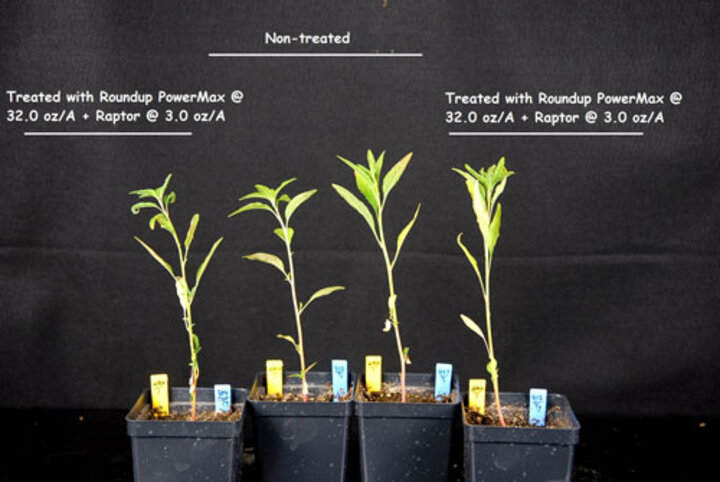
The evolution and widespread distribution of herbicide-resistant weeds and their management is a challenge for crop producers and land managers. The evolution of herbicide-resistant weeds is not new. The first report dates back to 1970, when common groundsel (Senecio vulgaris) resistant to atrazine was confirmed in Washington.
After commercialization of glyphosate-tolerant soybean in 1996 and corn in 1997, glyphosate has been used extensively for weed control. In fact, multiple times in a year. This resulted in the evolution of glyphosate-resistant weeds. By 2014, 29 weed species have evolved resistance to glyphosate worldwide, including 15 weed species in the United States. Six weed species in Nebraska have been confirmed resistant to glyphosate and some of them, such as common waterhemp (Amaranthus rudis), also are resistant to ALS-inhibiting herbicides (Classic, Pursuit, Raptor, etc.) (Table 1; Figure 1). They are known as multiple herbicide-resistant weeds.
| Table 1. Confirmed cases of multiple herbicide-resistant weeds in Nebraska. | |||
| Weed Species | Type of Resistance | Example Herbicides | Distribution in Nebraska |
| Common waterhemp | ALS | Pursuit, Classic | Throughout the northeast, southeast and south central Nebraska |
| Glycine | Roundup, glyphosate | ||
| Palmer amaranth | Triazine | AAtrex | A corn seed production field in south central Nebraska |
| HPPD | Callisto, Laudis, Impact, Armezon | ||
| Kochia | Glycine | Roundup, glyphosate | Isolated fields in southwest Nebraska |
| ALS | Express | ||
What is a multiple herbicide-resistant weed?
 Figure 2: Palmer amaranth resistant to atrazine and HPPD inhibitors (Callisto, Laudis, Impact) in a seed corn production field in Fillmore County.
Figure 2: Palmer amaranth resistant to atrazine and HPPD inhibitors (Callisto, Laudis, Impact) in a seed corn production field in Fillmore County.

Multiple herbicide resistance occurs when a weed species is no longer controlled by two or more herbicides with different sites of action applied at labeled rates. (Earlier these herbicides would have provided effective control of this species at the same application rates.) In other words, the weed species with multiple-resistance has acquired resistance against herbicides belonging to different chemistries. This is due to overreliance or continuous use of two or more selected herbicides over time. Multiple-resistance has been reported in several weed species. Recently, multiple-resistance was confirmed in Palmer amaranth (Amaranthus palmeri) in a continuous seed corn production field in Nebraska. The Palmer amaranth was resistant to HPPD-inhibiting herbicides (Callisto, Laudis, and Impact) and PS-II-inhibiting herbicides (atrazine) (Table 1; Figure 2). (See CropWatch article.) In fact, a population of common waterhemp in Illinois has confirmed resistance to four herbicides (AAtrex, Cobra, Raptor/Ultra Blazer, and Roundup), each with a different site of action. In the future, if integrated weed management options are not adopted, expect complex weed resistance issues and reduced herbicide options.
What is important to know to avoid multiple herbicide-resistant weeds?
Registered herbicides are classified into different groups based on their sites of action. The herbicide mode of action refers to the general biological process it uses to disrupt plant growth, produce symptoms, and kill susceptible plants. Sometimes, site of action is interchangeably used with mode of action, but specifically speaking, site of action refers to the exact site or exact enzyme where the herbicide acts to disrupt the growth of plants.
Knowledge of the herbicide groups and mode of action is important because herbicide resistance evolves not only in response to repeated use of the same herbicide but also with the recurring use of herbicide(s) belonging to the same group or mode of action. Hence, a rational and judicious use of available herbicides, along with other weed control methods, requires being aware of and selecting herbicides with different modes of action. A corn and soybean herbicide chart is available with groupings of all registered herbicides based on their sites of action. Herbicide programs should be based on selecting herbicides that belong to different sites of action to avoid selection pressure on individual herbicide.
Multiple herbicide-resistant crops
To combat the issue of glyphosate-resistant weeds, while maintaining the benefits of glyphosate-tolerant crop technology, seed and agrochemical industries have developed multiple herbicide-tolerant crops by stacking tolerance traits for additional herbicide chemistries. In stacked herbicide-tolerant crops, the herbicide-tolerant traits are combined to allow use of diverse herbicides and herbicide mixtures. For example, Roundup Ready 2 Xtend™ soybean (glyphosate- and dicamba-tolerant) and Enlist Duo™ (glyphosate- and 2,4-D choline-tolerant), Balance GT soybean (BalanceFlexx-tolerant). Using diverse herbicides or herbicide mixtures with different modes of action will reduce overreliance on any single herbicide and minimize the likelihood of selection pressure for resistance. This technology is expected to add a new tool to the weed management toolbox for control of resistant and difficult to control weeds. However, indiscriminate use or overreliance on this technology may result in more complex weed issues, including multiple herbicide-resistant weeds.
To avoid this, use an integrated weed management approach:
- Use weed-free crop seeds for planting.
- Prevent weed seed production by scouting the fields to control missed weed plants.
- Use residual herbicides.
- Select herbicides based on multiple modes of action.
- Apply herbicides at recommended rates and proper weed stage.
- Adopt cultural practices like manipulating row spacing.
- Use competitive cultivars, tillage, crop rotation, and use of mechanical management practices if feasible.
- Clean farm machinery to prevent seed movement within and between farms.
- Maintain borders to avoid weed seed influx.
- Take measures to avoid build-up of weed seed bank in collaboration and coordination with neighbors.
Zahoor Ganie, Weed Science Graduate Student
Amit Jhala, Extension Weed Management Specialist
